|
Monday, July 13, 2009
Progress Notes
As summer approaches the time of outdoor events also is on the way including fairs, dances, picnics, and festivals. In times past most of these events included some type of live music performance and dancing. I remember this was true at the Tuscumbia Annual Homecoming Picnic held in August each year. And even though our area is well known for its “country music” which nowadays includes a lot of what is called “bluegrass” music, back in the late 30’s and 40’s this area as well as the rest of the country was swept up in the big band “swing” sound. I remember as a child that one popular orchestra at the Tuscumbia picnic was the Doerhoff Family group from St. Elizabeth which played song after song of the big band and swing type of style (photo 01).
-Emil-Ida.jpg)
01 Doerhoff Orchestra - Ray, Norman, Leonard, Steve (Dad), Emil and Ida Fox Trot and Two Step and other dances were common. Of course, always there was room for the traditional country hoedown style music which was mandatory for the square dancing which was done at these events as well. One musical artist in this area who was accomplished at both styles of music was Gene Spencer of Eldon. Recently, I had opportunity to visit Gene and his wife Freda (photo 02).
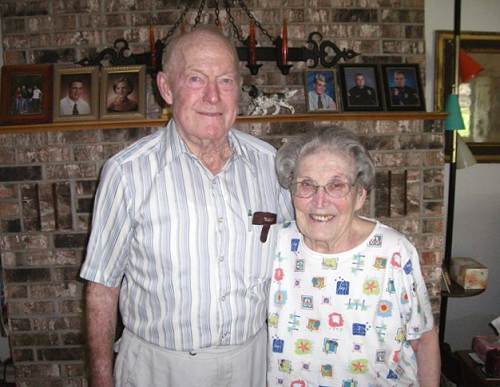
02 Gene and Freda Schulte Spencer I had known about Gene for many years going back to the 1940’s since he often played guitar in local bands. Most of the time Gene played swing type music but he also knew well how to play rhythm guitar for the square dancing which took place. Gene was considered years ago to be one of the best guitar players around because of his skill in playing the complicated chord progressions used by only the best guitarists, such as Eldon Shamblin, the well known Texas Playboys guitarist. One of the groups he played with early on in the late thirties and forties was lead by Blanch Crum of Olean. She played the piano, Bob Lindel was on Sax and Trumpet, and Doc Wolf on drums, both Bob and Doc being from Tipton. Mostly, Gene remembers, the band played 40’s swing style music for dance venues. Later, Gene played with many other groups, perhaps the longest with “The Valley Ranch Boys” (photos 03 - 07).
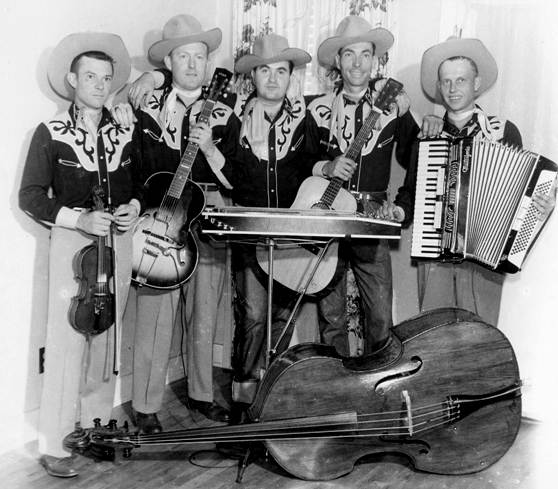
03 Valley Ranch Boys:
Jimmy Skiles, Gene Spencer, Buzz Bedwell, Merle Jackson and Ed Shepherd
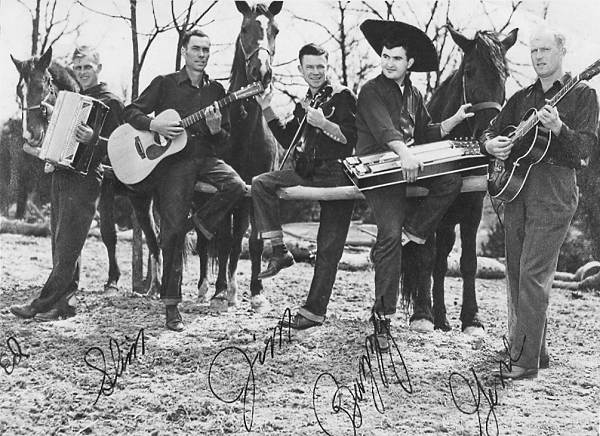
04 Valley Ranch Boys:
Ed Shepherd, Merle Jackson, Jim Skiles, Buzzy Bedwell and Gene Spencer
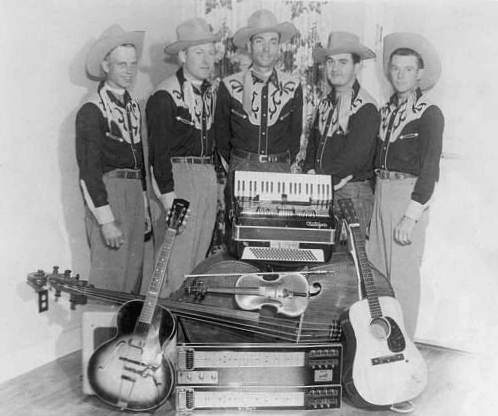
05 Valley Ranch Boys:
Ed, Gene, Merle, Buzz and Jim
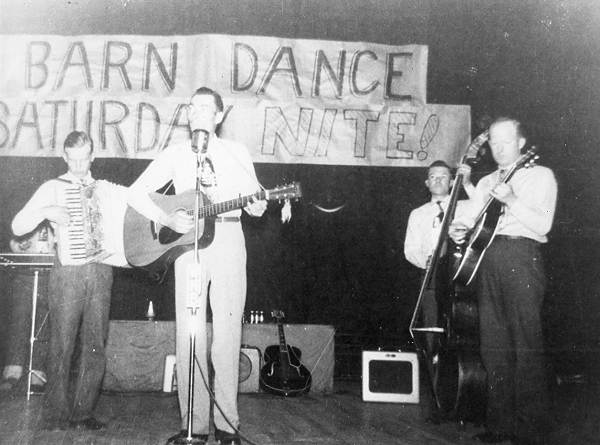
06 Valley Ranch Boys on Cowtown Jubilee in K.C.
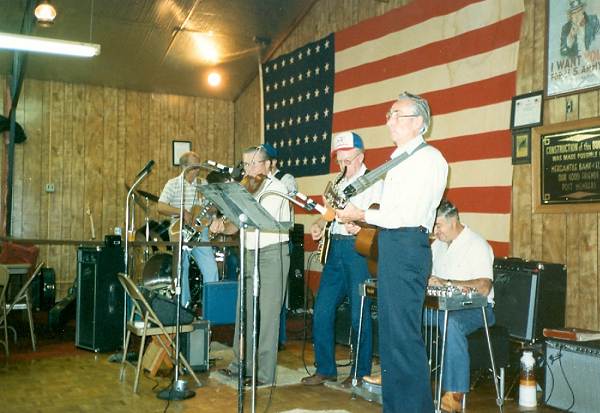
07 Valley Ranch Boys playing at Eldon VFW - 1986 Gene said the original name of this group was “Saline Valley Ranch Boys” but the “Saline” was dropped early on because it made the name too long. He also has played with the Chuck Huff (photo 08) and the Sweetwater bands occasionally (photo 09).
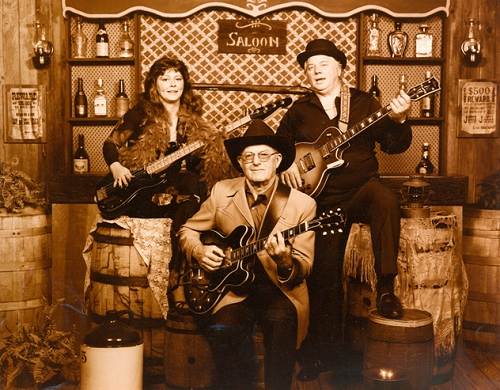
08 Chuck Huff Band - 1991
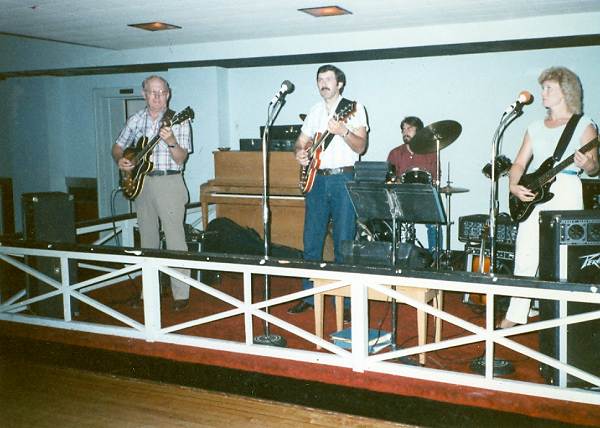
09 Sweetwater Band at the Eagles Club:
Gene Spencer, Mike Englebrecht, David Lepper and Rendy Lepper The last band he played with before suffering a stroke a year or so ago was the “Just us” band led by Ty and Patty Crane of Russellville (photo 10).
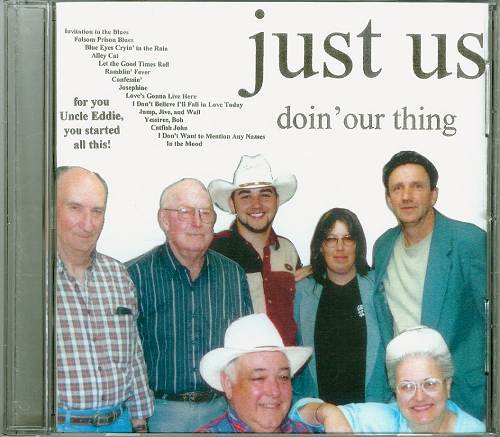
10 Just Us Band However, one of the most exciting periods in his musical career began in the early 1950’s when he was asked to be the guitar player on the Lake of the Ozarks square dance team. This local group was organized by several people including Lee Mace, Toliver Lawson, Spurgeon Atwill, and others. It gained national attention when it won the Ted Mack Amateur Hour’s first place prize in 1952 which lead to the opportunity to receive many requests for engagements across the country for two or three years.
Here is one of many newspaper articles which came out during this exciting time not only for Gene and the dance team but for all of Miller County (photo 13).
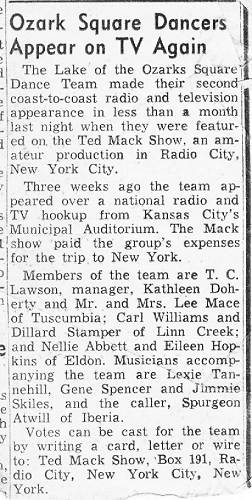
13 Ted Mack Amateur Hour Article
Click image for larger viewI was given a VHS copy of the Lake of the Ozarks Square Dance Team’s second appearance on June 13, 1953 on the Amateur Hour which was broadcast from Kansas City, MO by Betty McDowell, Gene’s daughter. You can view the dance segment here (Watch Video):
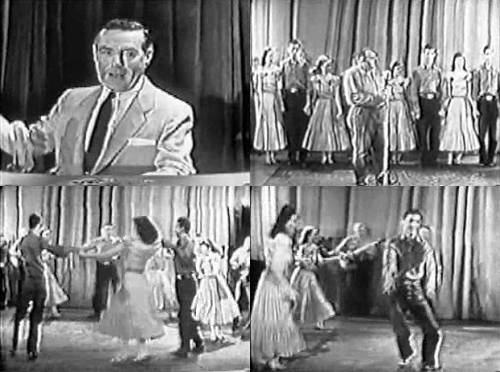
Ted Mack Amateur Hour - Lake of the Ozarks Square Dance Team - 1953
Click image to watch video (WMV format)
Here is a program content sheet of the team’s second appearance for the above mentioned Ted Mack show (photo 14).
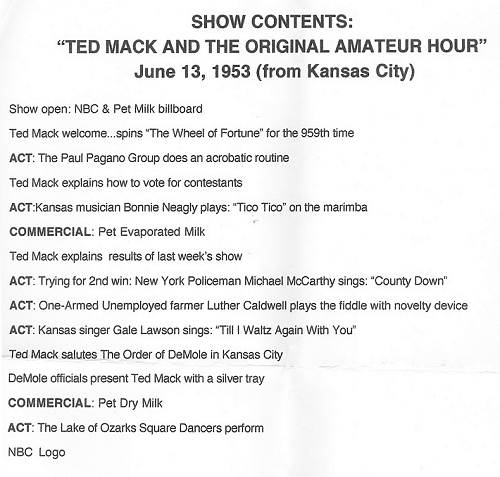
14 Ted Mack Amateur Hour Program Contents
Click image for larger viewYou can read more about the Ted Mack Amateur Hour at these websites:
- The official "Original Amateur Hour" website
- Wikipedia Entry for the "Original Amateur Hour"
Native Missourian Charlie Walden is recognized as one of the best Missouri old time fiddlers around who has won dozens of fiddle contests as well as major championships in Missouri, Illinois and West Virginia. He has his own website which I recommend to all to visit because of its authenticity regarding old time fiddling:
https://charliewalden.com
Charlie knew all the members of the Lake of the Ozarks Square Dance group. David Statler, who arranges the layout of the Presidents’s Page, contacted Charlie recently about the Ted Mack video. Charlie offered the following comment:
“The dancing in the video, although somewhat stylized for the performance, is entirely genuine Ozarks square dancing. Especially the footwork, called "jig-dancing" is the real McCoy and was unique to Missouri's Ozarks. That square dance group with Lee Mace was legendary among the old timers, now-deceased, that I used to play fiddle with.”
Following the win on the Ted Mack Amateur Hour the square dance team had several engagements for about three years. The longest one was for several weeks at the Blue Room of the Roosevelt Hotel in New Orleans (photos 15, 16 and 17).

15 Roosevelt Hotel
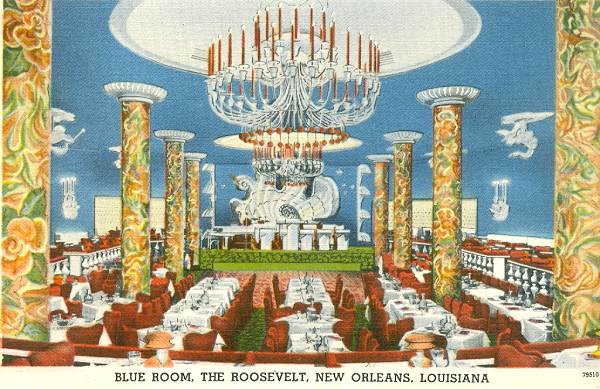
16 Blue Room

17 Square Dance Team at the Blue Room
Click image for larger viewThereafter, Gene continued to play for awhile with Lee Mace at the time that Lee was first beginning to organize his show, the Ozark Opry, which became so famous here at the Lake of the Ozarks. I discussed Lee and the Ozark Opry on a previous Progess Notes.
In 2003 the Ozark Opry held a two day celebration of it 50th year anniversary. Gene was one of the previous entertainers invited back to perform. In the following video of that performance you will note that Gene is introduced as being one of the “originals” of the first group of entertainers Lee had gathered together to start his show (Watch Video).
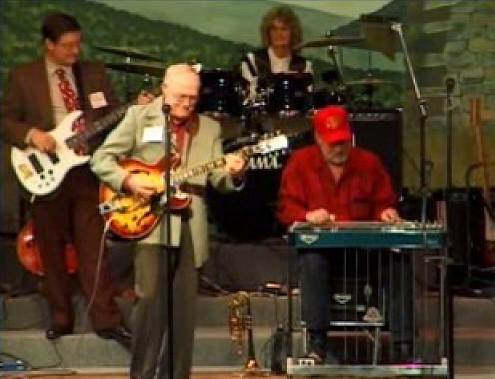
17a Gene Spencer at Ozark Opry - 2003
Click on image to watch video (WMV Format)Gene remembered that his first stringed instrument was a four string banjo. Later he bought a guitar for $5.95 which soon developed a warped neck. Later he acquired a Guild which was his favorite until he bought more recently a Gibson 335 (photo 18).
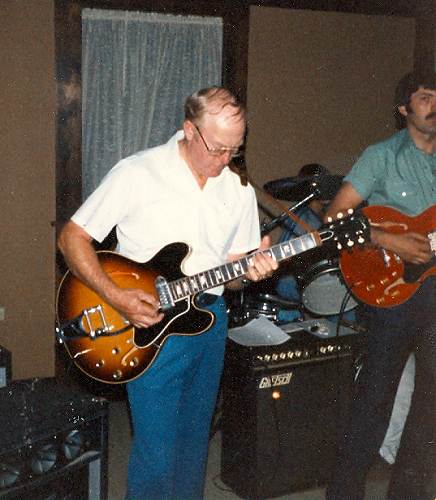
18 Gene with his Guitar Here is the bill of sale of his Guild which he bought from Harry Vernon at The Music Shop in Eldon in 1963 (photo 19).
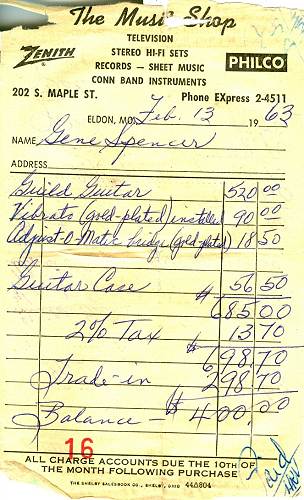
19 Bill of Sale for Favorite Guitar
Click image for larger viewAlthough his mother was a piano teacher, Gene cared much less for that than his guitar. He learned his chords mostly by watching other stringed instrument musicians. Because he became interested in the big band sound, early on he learned the more complicated chord progressions this style of music required. Gene told me that he was raised in a unique period of time when the radio and records mostly emphasized the big band sound and that the traditional hill country music with which he was raised was not nearly as popular as it is today. His first professional playing began at an early age when he was fifteen years old in the middle or late 1930’s.
What I admired about Gene was the versatility he demonstrated as a performer being able to play all types of music including jazz and modern styles. One time many years ago in the early 1960’s when he was accompanying my sister, Patricia Pryor (who played the piano by ear) at a friend’s house, I watched in amazement as he by ear easily went through some fairly difficult chord progressions as she played from a selection of big band songs from the 1940’s.
Gene’s father, William E. Spencer, originally was from Indiana but moved to the Iberia area in the early part of the last century where he met and married Gene’s mother, Maggie Crane Spencer (photo 20).
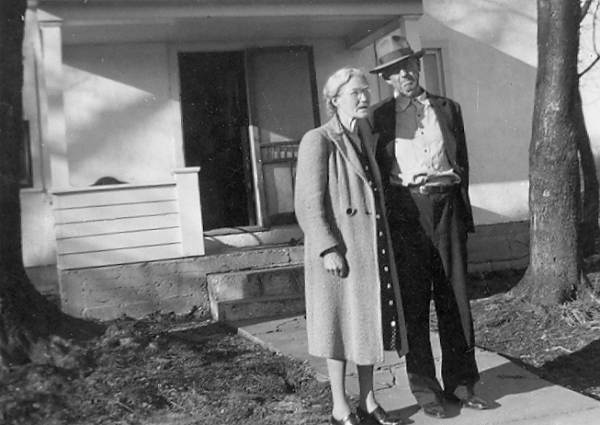
20 William and Maggie Crane Spencer Later the couple moved to a farm near Eugene on the Tuscumbia Eugene road where Gene was born in 1923. You can locate Gene’s home farm on this plat map identified by his father’s name, William E. Spencer, in sections 11 and 12 (photos 21 and 22).

21 T41N R14W

22 Sections 11 and 12 William, Gene’s father, insisted his name be spelled “Jean,” because he didn’t want his son to have the name Eugene, apparently because of some type of dispute he was having at the time. But Gene said that this confusion of spelling caused him a lot of grief in the armed services. At any rate, everyone now knows him as Gene, not Jean, even though today on all his official papers his name still is spelled “Jean”. Here is a photo of Gene at age eight (photo 23).
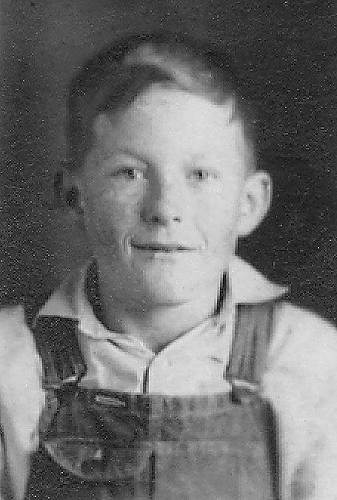
23 Gene as a Boy Gene went to the Gageville one room school for his elementary education where he remembers one of his teachers was Parnell Kallenbach, who later became a physician practicing in Mexico, Missouri (photo 24).
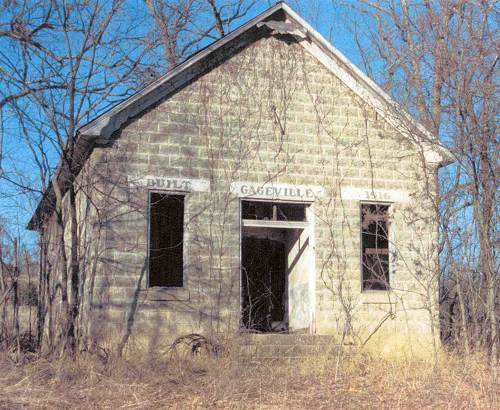
24 Gageville School House - 2007 Later Gene attended Eugene High School where he met his wife, Freda Schulte from the Mary’s Home area, who is a cousin of Leonard and brother of Tony Schulte, well known farmers who settled north of Tuscumbia. Here are some photos of the well known Schulte family of the Mary’s Home area which Freda let me copy (photos 25 - 28).
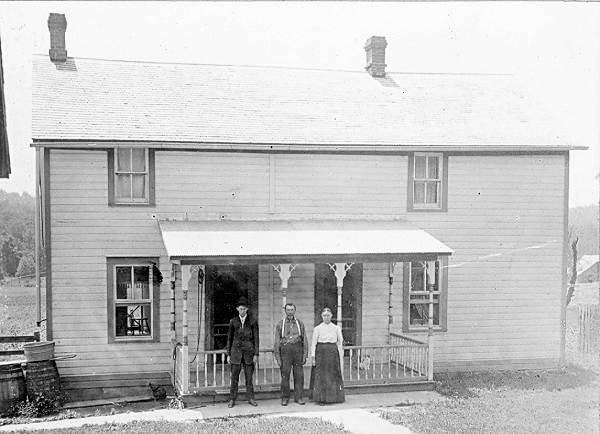
25 August and Elizabeth Schulte and Son Lawrence Schulte - Father of Freda on Jim Henry Creek
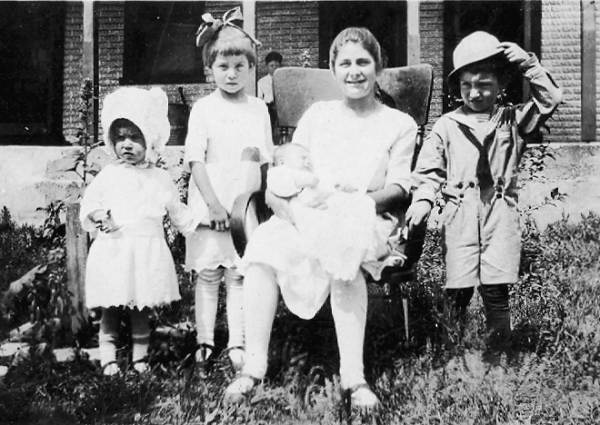
26 Freda Schulte, Pat Schulte, Catherine Bauer with Stella Schulte and Tony Schulte

27 Lawrence and Elizabeth Buetel Schulte, Stella, Tony, Pat and Freda
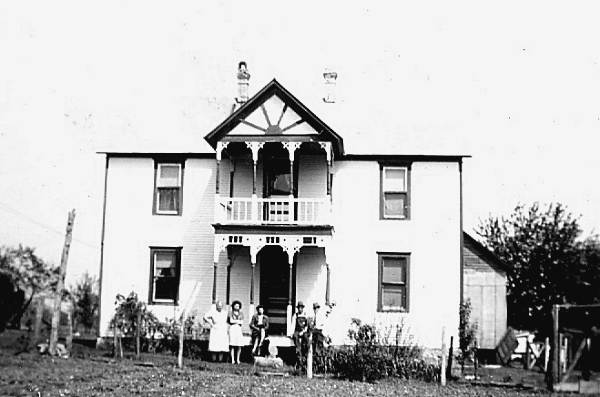
28 Lawrence and Lizzie Schulte home in Mary's Home
Now home of the Knights of Columbus Ballfield One of our long time Miller County Historical Society board members, Helen (Heafy) Schulte, was married to Leonard Schulte, a cousin of Tony Schulte. Helen’s sister, Clara, was married to Tony Schulte, Freda’s brother.
Growing up, Gene, in addition to his routine farm chores, also helped his father, William, in a well drilling business. Gene said originally, his father used a team of horses which walked a circle turning a drill bit to dig the wells. Although this was a faster and deeper method than the hand dug well, it still was quite primitive by today’s standards. Later, his father bought a steam engine which turned a wheel that mechanically oscillated a lever which caused the drill bit to go up and down vertically. The bit had to be heated over a forge and sharpened four to five times daily. Later a gasoline engine replaced the steam engine, and finally, an integrated system was designed wherein the drill was raised up and down by a PTO run off a truck. The next two photos depict an example of this type of rig which belonged to William (photos 29 and 30):
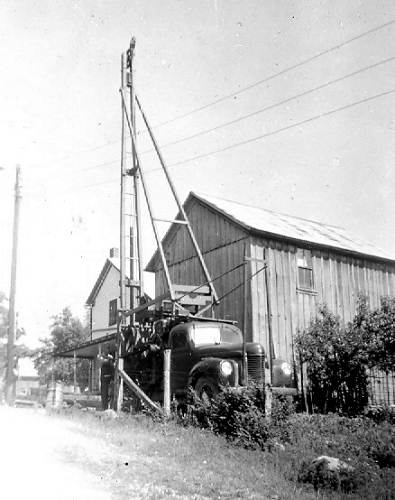
29 Drill Unit
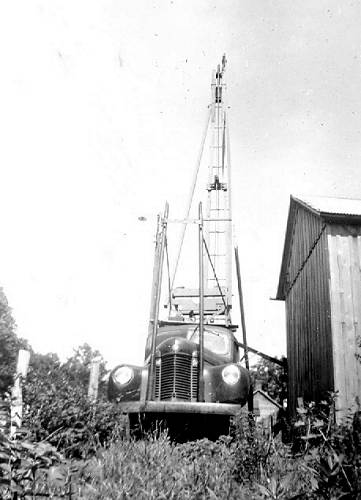
30 Drill Unit Gene said his father kept up with all the innovations in drilling in those days and was the first in the area to acquire an air drill. Gene remembered that his father had drilled the well for my father’s house in Tuscumbia when I was about four or five years old.
In the early 1940’s Gene worked with other Miller County locals at Fort Leonard Wood when that training center was first being developed (photo 31).
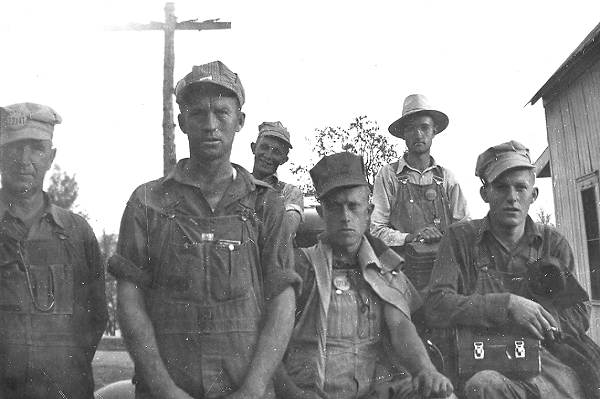
31 Fort Leonard Wood - 1941 - Gene on Far Right When WW II began Gene joined the Navy. Here is a photo of Gene while still at boot camp (photo 32).
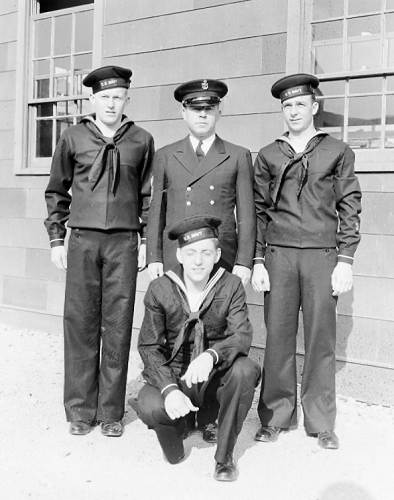
32 Boot Camp - Gene on Left Back Row Although he qualified for several assignments including mechanical skills, Gene’s musical ability was discovered and he eventually wound up in Sun Valley Idaho at a convalescence hospital for emotionally disturbed returning veterans. Gene was involved in providing musical events for the soldiers as well as singing in the Great Lakes Naval Choir. Every Friday evening on a show entitled “Meet Your Navy,” this group performed on Chicago radio station WLS. One good friend Gene made while at Sun Valley was physical training instructor, Jack LaLayne, who even then, was involved with physical training therapies of various kinds for the servicemen. The name of his program was “Physical Culture Studio.” Jack gave Gene this photo before Gene was reassigned (photo 33).
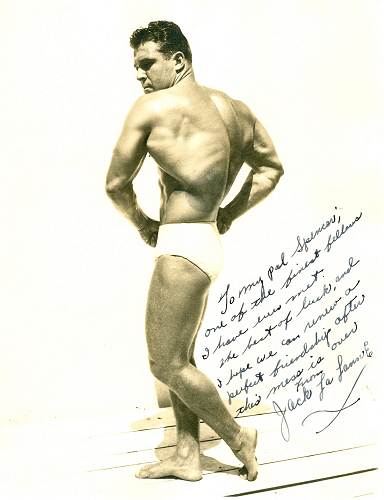
33 Gene's Friend Jack
Click image for larger viewOn his next assignment Gene was asked by the Navy to put together a musical group which provided music for various local events in the Twin Falls, Idaho area. After his tenure in Idaho, the Navy transferred Gene to a Marine Corps unit where he remained until the end of the war (photo 34).
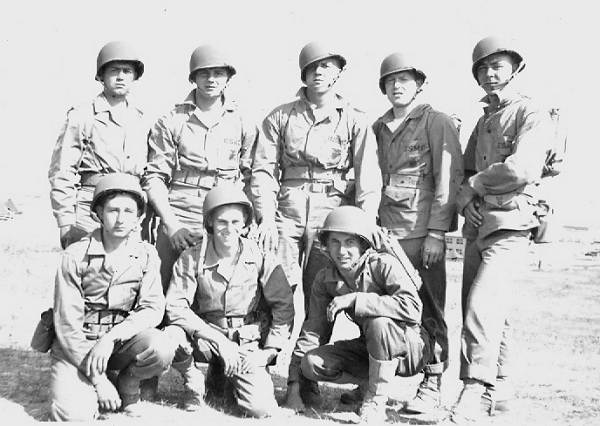
34 Marine Corps - Gene 4th from Left On returning home, Gene and Freda married in 1946 (photo 35) and they celebrated their fiftieth anniversary in 1996 (photo 36).

35 Wedding Photo - 1946 - Freda and Gene
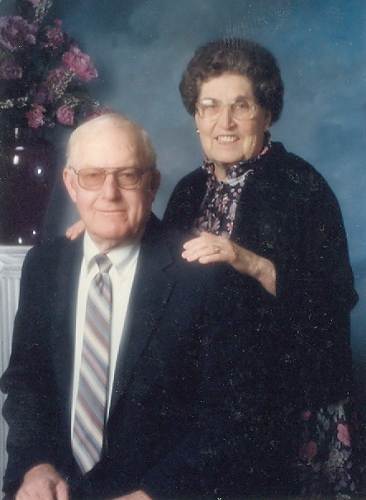
36 50th Wedding Anniversary - 1996 In the 1950’s Gene received training to become a telegrapher and began to work for the Rock Island Railroad. Several transfers were required by the railroad requiring Gene and Freda to move every once in a while. His final move was to Eldon. He remembers how excited he was when he was able to work out a schedule with the Rock Island Company which would allow him to play guitar for the Lake of the Ozarks square dance team during its appearances on the Ted Mack Amateur Hour contest as was discussed above. In this next photo Gene and his family are pictured on the porch of the home in Eldon close to his office at the station (photo 37).
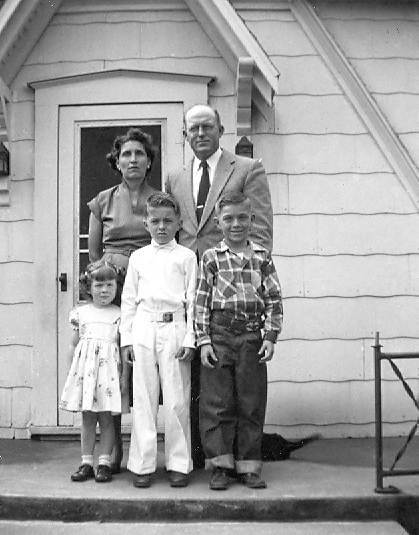
37 Gene and Freda, Betty Gale, Larry and Ron And in this photo it appears Gene was getting his boys off to an early start in the music business (photo 38).
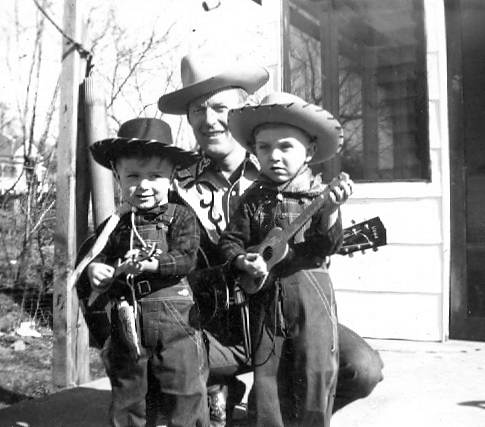
38 Larry, Gene and Ronald After returning to Eldon, in addition to playing with several musical groups at dances and other events, Gene also performed at special events such as the day he appeared at the Courthouse in Tuscumbia (photo 39).
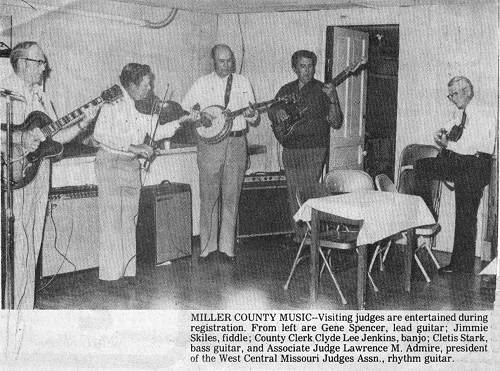
39 Gene and Group before Miller County Court
Click image for larger viewNotice that Eldon resident Lawrence Admire was sitting in on that session. Gene also involved himself with the VFW as shown in these two photos (photos 40 and 41).
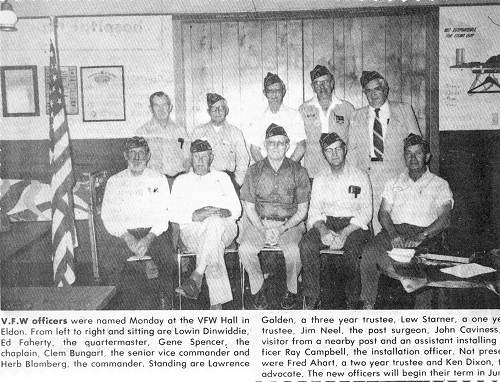
40 Gene in VFW
Click image for larger view
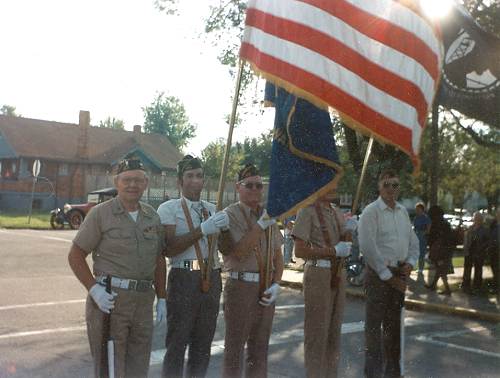
41 Gene in VFW Parade Gene is one of those quiet guys who these days you might never know had had such an interesting life. But I am old enough to remember all the excitement around the county when the Lake of the Ozarks Square Dance team was appearing on Ted Mack’s show as well as having long engagements in New Orleans and in Nashville on the Grand ‘Ol Opry.
We were honored recently by two historical gifts from the Brockman family of Tuscumbia, given us by J. C. Brockman, son of C.O. (Oliver) Brockman and grandson of John N. Brockman (photos 42 and 43).

42 J.C. Brockman
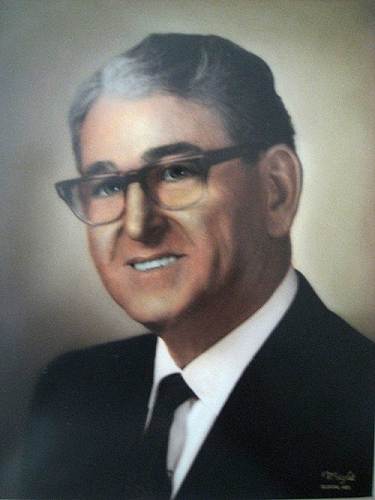
43 Oliver Brockman The items were two different stamp seals, one belonging to the Old Bagnell elementary school, and the other belonging to the Tuscumbia Telephone Company, which served Tuscumbia before being incorporated into the Bell Telephone system in about 1932.
The Bagnell School seal is handheld and shows wear on the handle (photo 45).
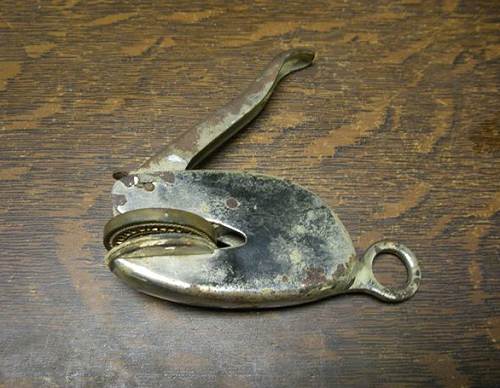
45 Bagnell Seal The embossing of the seal lacks some clarity of the print (photo 46).
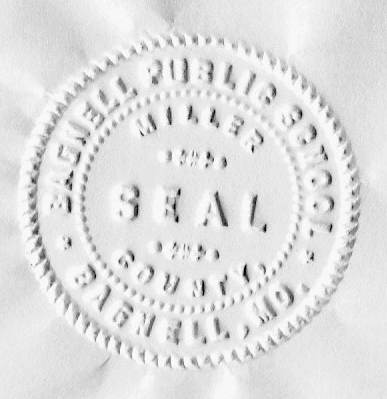
46 Bagnell Public School Seal It was acquired when Oliver Brockman was the school superintendent. The Bagnell School was closed in 1939 with the consolidation into the School of the Osage (photo 47).
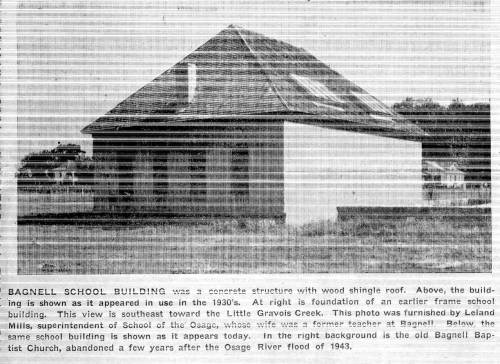
47 Bagnell School
Click image for larger viewOliver was the last superintendent of the old Bagnell School. The Baptist Church was located behind the school where Oliver also was Sunday School teacher (photo 48).

48 Oliver Brockman (at left) - Sunday School at Bagnell Church - 28 SEP 1924
Click image for larger viewThe Tuscumbia Telephone Company seal is black and stands on its own. It does show some wear on the handle (photo 49).
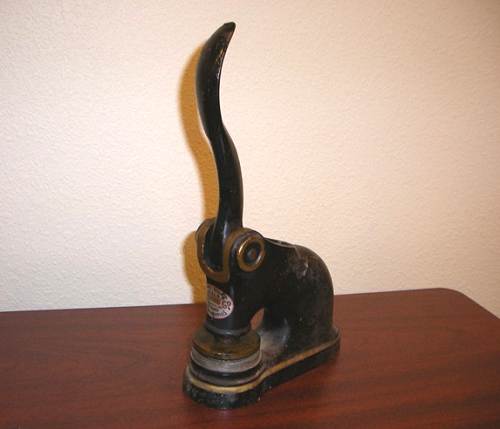
49 Telephone Seal There is some limit to the embossing and clarity of the print (photo 50).
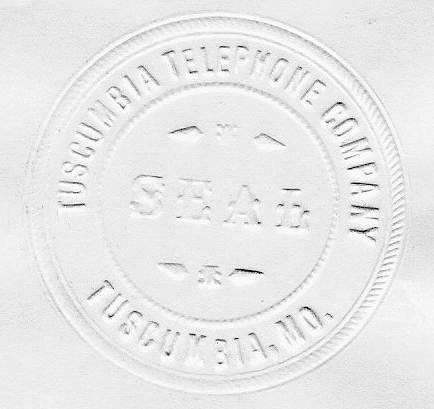
50 Tuscumbia Telephone Company Seal The Tuscumbia Telephone Company was owned and operated by Judge John N. Brockman. The Company was operated from Mr. Brockman’s Home Hotel until it was sold to Bell Telephone in the mid 1930’s (photo 51).
Hotel-Old.jpg)
51 Home (Brockman) Hotel - Old Oliver Brockman came to Tuscumbia with his father, John N. Brockman, who in 1905 had been elected to the position of County Judge, a position he held until 1909. Here is a photo of John taken about 1909 along with the other County officers of the time (photo 52).
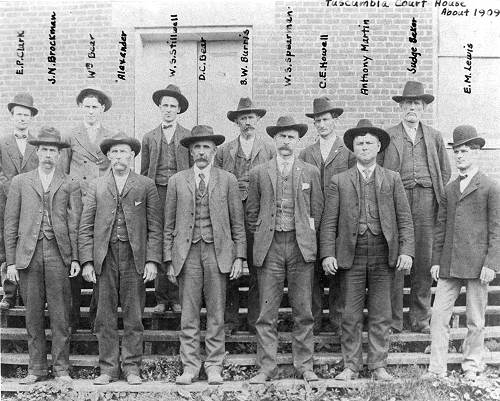
52 County Court - 1909
Click image for larger viewJohn and his wife purchased the old Home Hotel in 1913 which up to then had been owned by the Ludwell Bacon family. Oliver's mother ran the hotel until her death in 1952. John N. Brockman rented apartment rooms in the old hotel thereafter until he died in 1959.
The Brockman Home Hotel was a landmark in Tuscumbia for many years. At the time of its razing in 1968 an article was published in the Tuscumbia Autogram detailing some of its history:
Tuscumbia Autogram
1968
Miller County Hotels
BROCKMAN HOTEL
TUSCUMBIA LANDMARK RAZED
A Tuscumbia landmark, the building familiarly known as the old Brockman Hotel, was being razed this week (photo 53).
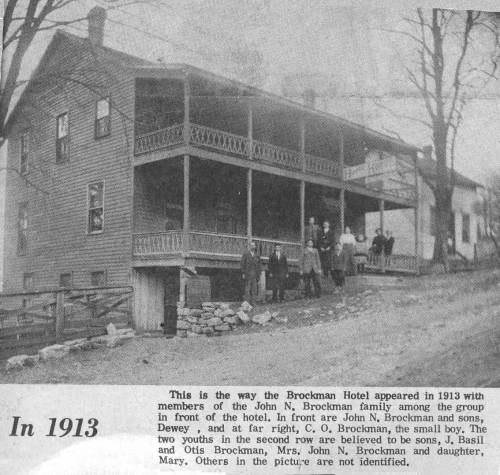
53 Brockman Hotel - 1913
Click image for larger viewA Tuscumbia landmark of Pre-Civil War vintage, now commonly referred to as the Old Brockman Hotel, formerly called the Home Hotel, and even earlier as Central Hotel, is coming down. Cecil Apperson is in charge of the wrecking procedure (photo 54).
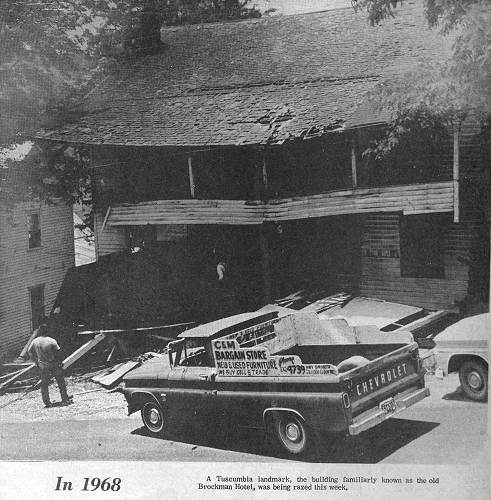
54 Brockman Hotel - 1968
Click image for larger viewThe family of the late Mr. and Mrs. J. N. Brockman moved there from the Brockman farm upriver in 1905 when Mr. Brockman was elected a county officer. Mr. Brockman continued to live there until his death in 1959.During the later years of his life it was rented by Mr. Brockman as furnished apartments. For the last several years only the basement, housing a self-help laundry, has been used while the porches and other parts of the building have deteriorated.
C.O. Brockman, youngest of the J.N. Brockman sons, and the only one of the family still living in Tuscumbia, is the present owner. When asked about the history of the building, Brockman said he could only account for it since their family moved to Tuscumbia in 1905. It was then occupied by the Ludwell Bacon family. Mr. Bacon, he recalled, died there in 1906.
The building was painted a deep barn red when the Brockmans moved there. Mrs. Brockman had it painted white with cocoa trim, and later all white. Abstracts and other papers show that Mrs. Brockman often made payments on the property of as little as $10.
The building had 13 rooms, a washroom, and a full basement. The ground level basement was used as kitchen and dining room. The family ate after the guests had finished. Seven sleeping rooms were on the top floor and the lobby and ladies' guest room on the main first floor were also used by the hotel guests. All rooms were frequently filled, especially during court weeks.
There was no electricity or running water in those days, however, Brockman recalls that his mother had a lavatory put in the hall, using water from a ten gallon stone jar, which the boys filled every morning, so the guests could wash up as the come in and before meals. Meals were 35 cents, and later raised to 50 cents, Brockman remembers, although he doesn't believe the price was ever more than $1 for a bed.
Clyde Lee Jenkins in his historical study of the town lists this and two other hotels to accommodate the public around 1885. Amanda Adcock was proprietress of the Central Hotel (this one); Edith Freeman, proprietress of the Tuscumbia House which was directly across the street; and Benjamin Lawson, proprietor of the hotel on the river bluff. Other business places listed at that time include two general stores, four saloons, and two blacksmith and wagon shops.
One of the old stories concerning the building, although not completely authenticated, concerns a man who was either killed or committed suicide in one of the upstairs rooms. Another concerns a "drummer" who took down with smallpox there and the place was strictly quarantined for some time. Others who had been with the man or been exposed were taken to a place a few miles outside of town and required to stay there, it is said, until it was sure none would take the dreaded disease.
During the "horse and buggy" days, the hotel business thrived when the traveling salesmen, school teacher who came to the county seat for teachers examinations or teachers meetings, lawyers, and others involved in court cases as well as interested spectators, and many other business people and travelers often stayed overnight at the "hub".
Here is a photo of the Brockman/Home Hotel taken in the 1940’s by my father (photo 55):
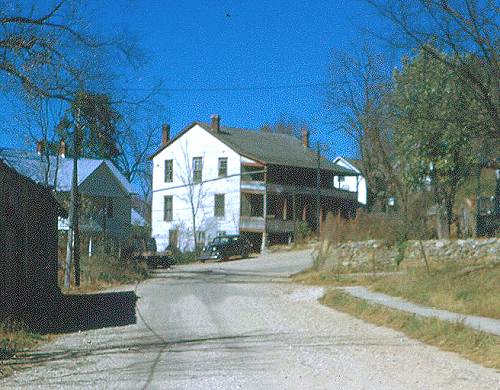
55 Brockman Hotel - 1940's I remember the old Brockman Hotel well because my grandfather lived in a log house across the road from the Hotel. This home is still present and has been remodeled some (photo 56).
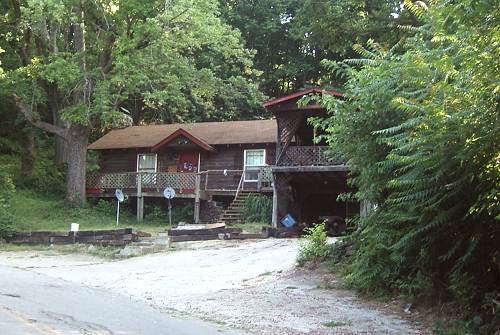
56 Madison Bear Home I remember the old telephone office. At that time the telephone office had been moved out of the hotel into a small house next to the hotel. When Mrs. Brockman wasn’t acting as operator, Mabel (Ramsey) Curry filled in. I still can see her plugging and pulling those banana type plugs in and out of the holes of the switchboard on top of the desk. She often had to eat while working as operator. Another operator was Susie Day, mother of Marie Day Pryor wife of Ansel Pryor. In our own home at the time we still used the old time ring phones with the mouthpiece on the wall and the earpiece held in the hand.
My Aunt Bonnie (Bear) Tyler has an interesting story which includes her memories of the old Tuscumbia Telephone switchboard during the time she lived with her parents, Madison and Sadie Bear, across the street from the Brockman Hotel. Bonnie was a teen ager then. Here is a graduation photo of her taken just a few years later than the time of the story she narrates (photo 56a).
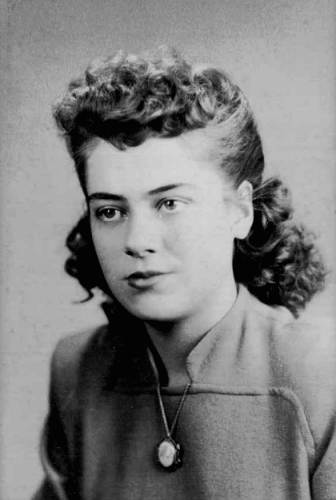
56a Bonnie's Graduation Photo - 1947 And here is Bonnie’s story:
During the great flood of "43" when the waters had the audacity to reach into our upstairs in Goosebottom (Note: Goosebottom was the local name for the valley and road where the riverside park is located in Tuscumbia) we moved out in the middle of the night when some boats came and pecked on our upstairs windows to tell us that the water was going to rise a lot higher. We, of course, always took everything upstairs when there was danger of a flood and the piano was always strapped to the 12 ft. ceiling of the living room. Altogether we lost 3 pianos to the Osage River during the later years when the floods got bigger and bigger.
Floods came only about every six years and usually just covered the road until Bagnell Dam was built. After that everyone below was at the mercy of Union Electric. Not always did the water get into our house but the frequency grew through the years. One year we had 3 floods, but 43 was the last one that we would endure. At that time we had 8th grade graduation ceremonies for the county at Tuscumbia and everyone would walk from the court house to the school. I had to change into my pretty dress in our upstairs in Goosebottom while the water flowed through the downstairs. Then we rowed across to high ground, walked up the long flight of steps and proceeded to the graduation.
(Note: These are the 117 steps up the hill leading from the river valley to the Courthouse.)
A few days after that, after we had all gone to bed upstairs there came a pecking on our upstairs windows. It was people there in boats who came to move us out. They said that the report was that the water was going to rise several more feet. So as many of our possessions as they could take were moved to the 4 room log cabin which Dad owned on the side of the hill above the Brockman hotel. Imagine a ten room house and moving to a 4 room cabin. Of course many of the handmade beautiful desks, bureaus, closets etc. which were made by my great grandfather (George Bear, a cabinet maker) were lost because they were so large and heavy. But it was a beautiful example of neighbors helping neighbors. They even floated our Frigidaire across by towing it. It was plugged in at the log cabin and worked perfectly.
So Dad decided that we would stay put and not go back to the home I loved. After all, we had spent many times cleaning, painting and fixing up after floods. Yet today I think so fondly of that home because of the many people that passed in and out of our lives there.
Note: This was the original Phil Hauenstein home. It was sold by Madison Bear, Bonnie’s father, and the purchaser tore it down to harvest the lumber for resale in Eldon. Here are two photos of the home before and during the ’43 flood a few days before it reached the upper story (photo 56b and 56c):
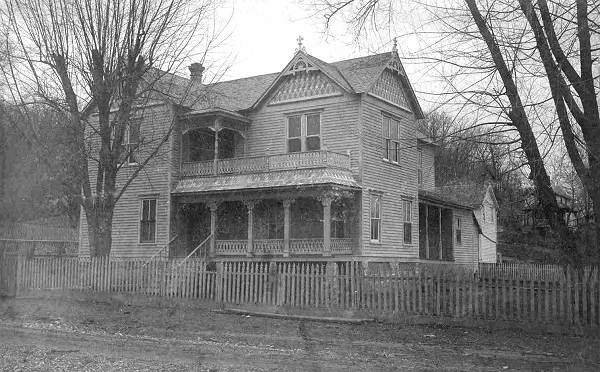
56b Phil Hauenstein Bear House in Goosebottom
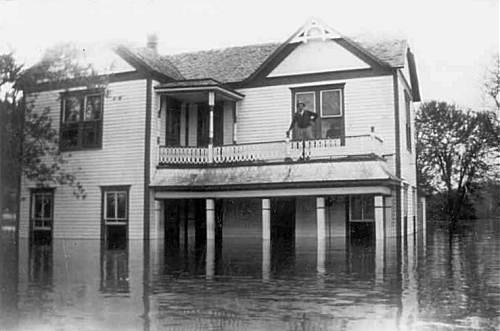
56c Goosebottom Home in Flood But flood times were exciting times. We had fun rowing the boats and fishing in the front yard even though it was very destructive to a lot of people, especially farmers.
The log cabin became our home from then on….. eighth grade graduation over, high school years ahead. Just down the hill slightly and across the street was the telephone office which was operated at that time by Etta Abbott (they spelled it differently than Mom's family which was spelled Abbett; but that’s another story) and Lucy Hawken, Etta’s daughter. Mom and Dad were friends with Oscar and Etta and the family so I would go across the road and watch them at the switchboard. It was fascinating to watch. When someone would ring in, a little metal square would drop down and the operator plugged a cord into the opening exposed by the drop and say "number please". Then they would bring up a cord which was behind the one they had put the plug in, plug it into another hole and the two were connected after the operator rang the number.
Sometimes they would ask me to watch the switchboard for a short time while they did something else and it was so much fun because I could be nosy and listen if I wanted to. Being a teenager I wanted to most of the time. Especially listening to some of the the older guys talking to their girlfriends. I heard language from one in particular which was quite offensive so I backed off from listening. But all you had to do was to hold back on a metal piece which was behind the two cords which were plugged in to connect the talkers. By doing this they could not hear anything from your side. No wonder telephone operators knew everything.
Thanks Bonnie.
The Brockmans' originally had come from the Old Bagnell area but the extended family owned land in several locations including a large spring known as Brockman Spring which was located near the Osage river just a few miles west of Tuscumbia. As noted above, Oliver had taught school and attended church in Old Bagnell before coming with his father to Tuscumbia. He married Ila Calkin from Passover Mo. who also had taught in a one room school near Old Bagnell. Oliver and his family were very influential in Tuscumbia where Oliver was known as a respected leader of the Tuscumbia Baptist church. He also was the developer and owner of the Brockman's Wood Products Company. For many years Oliver was the Postmaster of the Tuscumbia Post office located at the time in the concrete building under the hill along the bluff across the street from Hauenstein's General Store.
Further information about Brockman's Wood Products Company can be found on a previous Progress Notes.
The following article was taken from the Eldon Advertiser of June 18, 2009 written by Gloria Irwin, daughter of Ray Behrens who recently passed away. Ray was married to Brooksie Bowlin of Bagnell who passed away a couple of years ago. The Behrens were well known around Bagnell and the School of the Osage for the many community services in which they were involved. Ray was quite an historian to whom we at the Miller County Museum often turned as a reliable resource for much of history of the Bagnell area. For example, a significant contribution to our website section about Old Bagnell was given to us by Ray during an interview two years ago which you can read here:
http://www.millercountymuseum.org/communities/bagnell.html
Eldon resident dies
before Honor Flight
BY GLORIA BEHRENS IRWIN
June 18, 2009
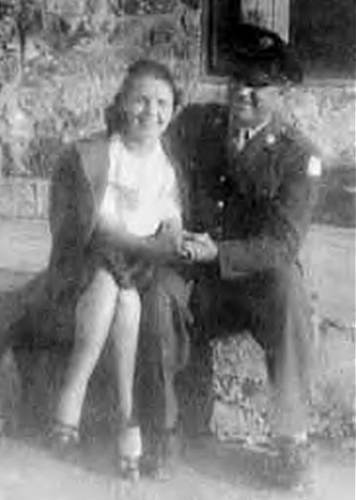
Sgt. Raymond C. Behrens, U.S.
Army, was home on furlough
when this photo was taken in
1945. He is shown with his
wife, Brooksy Behrens, in Old
Bagnell, where the couple
made their home at the time. Longtime Eldon resident Ray Behrens would have been one of the oldest veterans on board the June 16 Honors Flight trip to Washington, D.C. to see the World War II Memorial. He died less than two weeks before the planned trip. The Honor Flights, which have been carrying World War II veterans to Washington, D.C. to visit their memorial, are now known nationwide and are free of charge for World War II veterans often referred to as “The Greatest Generation.” With some 1,000 World War II veterans dying each day, the flights are a special way to honor those who served their country.
When Behrens, a tech. sergeant during World War II, heard about the Honors Flight program, he immediately applied and eagerly awaited his acceptance for the flight. Behrens, who was 29 when he was drafted in 1945, would have been one of the oldest on board. Daughter Gloria Behrens Irwin said she often heard him tell that story. “The draft board had assured me that because of my age and because I had a wife and child, my draft number would never come up,” Ray Behrens often said. “But then,” he’d add quickly, “up jumped the devil – the Battle of the Bulge.” That long standoff in Europe meant more were needed in the military and Ray’s “greetings” letter soon arrived from the draft board.
Wife Brooksy, 5 foot 2 inch and petite, then donned her own uniform, taking over the family oil distribution business and driving the big gasoline trucks in his place. Thanks to her, when Ray was eventually discharged, his business was thriving.
Ray and Brooks were married for 70 years, and after Brooksy’s death in January 2008, Ray never fully regained his vitality and zest for life. But then recently he talked of the Honor Flight, his wide smile and enthusiasm returned. During the week of May 17, Jim and Gloria Irwin flew from their home in Southern California to help Ray celebrate his 93rd birthday. He was hospitalized at Capital Region Medical Center at the time, then returned to his room at Heisinger Bluffs in Jefferson City for skilled nursing care. Soon thereafter a letter from the Central Missouri Honor Flight administrator was delivered to his room, postmarked May 26. It read, in part, “We are so pleased that you will be joining us on June 16, 2009. We will have a great time.”
He was never to read that letter. His health had declined rapidly, and on May 27, he died. At his funeral service, the American flag covered his coffin and a photo was displayed of him in his Army uniform. Among the floral tributes was a large, red, white and blue spray with a card that read “Ray will be with us in spirit on the 16th. Our condolences, Central Missouri Honor Flight.”
The military honors performed at his gravesite by Miller County VFW Post 2442 were a moving reminder once again of “The Greatest Generation” and how much we owe all those who have served our country.“ That solemn ceremony and the unexpected floral tribute from the Honor Flight touched our family deeply,” Gloria Irwin said. “The Honor Flight administrator had also asked that we send a photo of dad for one of the veterans to hold up at the World War II memorial. Dad would have liked that. It’s almost as if he took the flight afterall.” “Ray has taken another flight now,” said son-in-law Jim Irwin, “an even better one. This time it’s an Angel Flight.”
More than seventy five members of the Kallenbach family attended their reunion celebrated at our museum last June 6. Miller County Kallenbachs’ now are distributed across the entire U.S. and quite a few attending were from out of state. The event this year was especially meaningful because Mary Lou Roberts, a recognized Kallenbach descendent historian, had donated all her research work to the museum library just a few days before. The hosts this year were Brice and Betty Kallenbach who did a superb job of preparing and decorating the meeting area for the event (photo 57).

57 Kallenbach Reunion - Tom Snodgrass, Kallenbach descendent, Smiling at Camera That's all for this week.
 Joe Pryor
|



